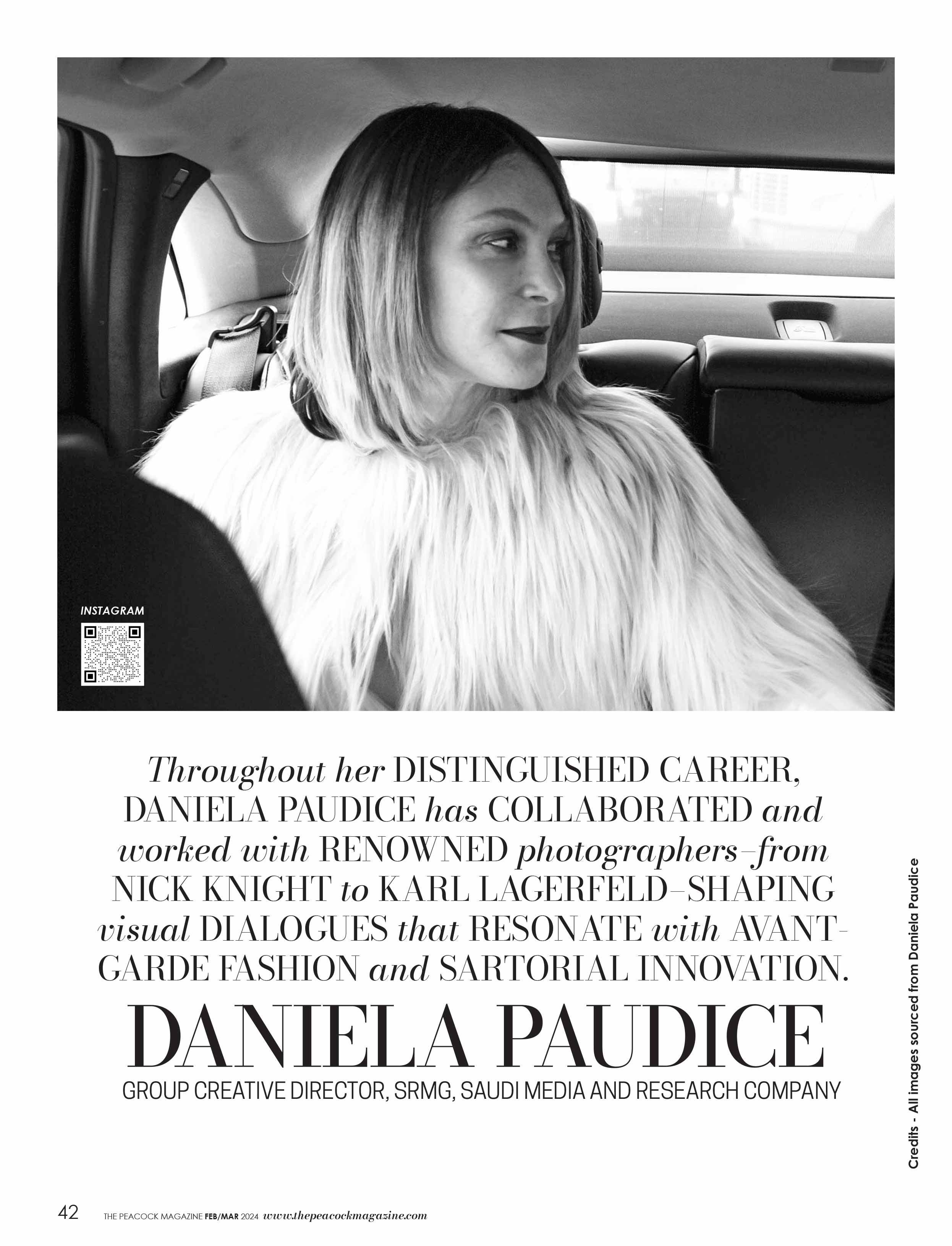
CREDITS – All images sourced from Daniela Paudice
Throughout her distinguished career, Paudice has collaborated and worked with renowned photographers–from Nick Knight to Karl Lagerfeld–shaping visual dialogues that resonate with avant-garde fashion and sartorial innovation
Daniela Paudice, currently the Group Creative Director at SRMG, Saudi Media and Research Company, doesn’t just orchestrate the artistic direction of fashion and lifestyle titles for the group. With a vast experience of almost 30 years, she is the one who puts the trend on the charts which then has a chart-busting run for years to come—and all this, thanks to the invisible “antenna” that she confesses to have. Paudice started her journey in London as a Fashion Editor for the Sunday Times Style Magazine, and she swiftly navigated through esteemed roles at Vogue UK and Tatler. Her creative prowess has left an indelible mark, steering the visual narratives of global fashion publications like Vogue China, Vogue Singapore, and Vogue Russia, imprinting her legacy across London and New York City.
She sits down to have a conversation with The Peacock Magazine where she talks about her favourite fashion films, her take on the newly developed visual languages and how Gen-Z inspires her.
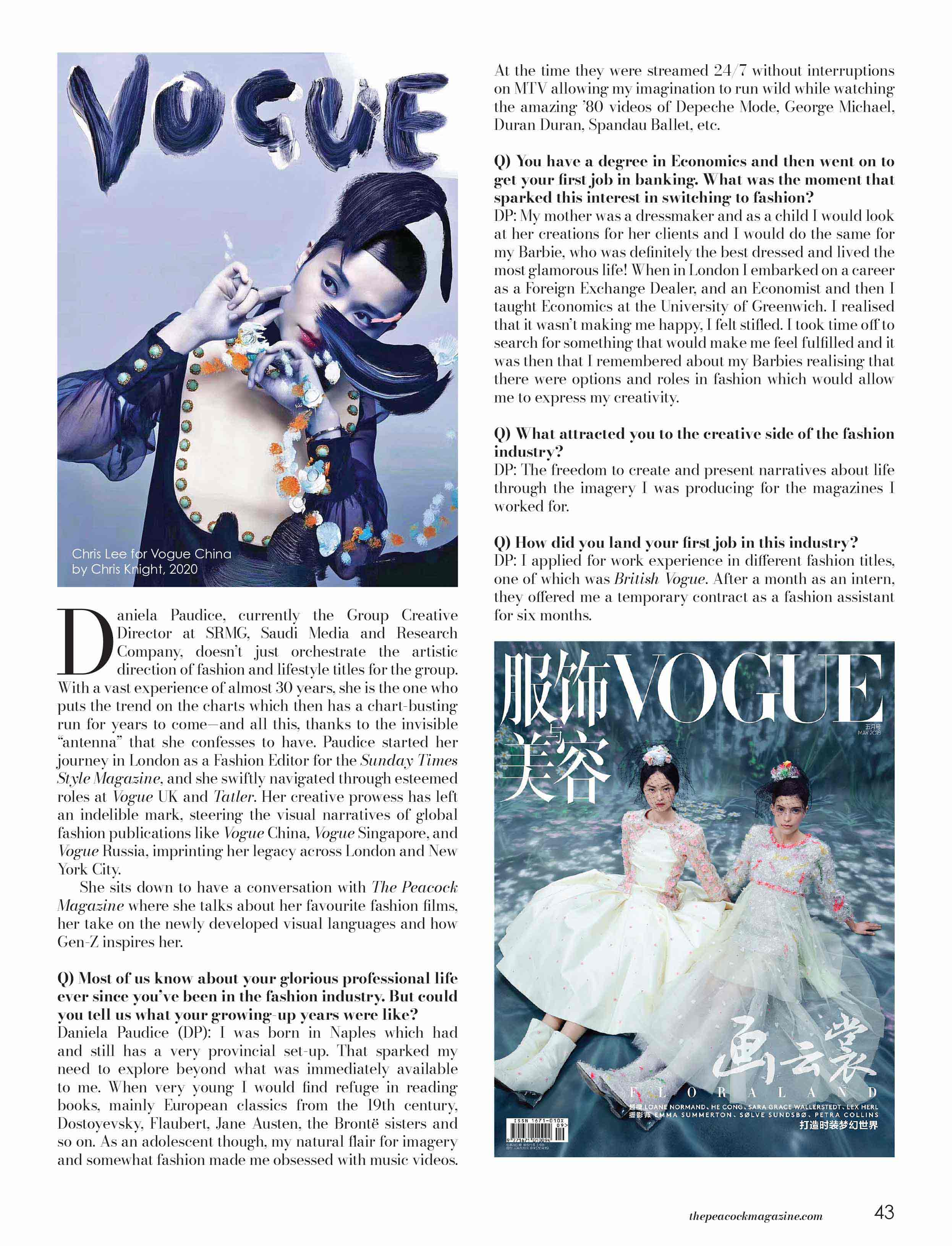
Q) Most of us know about your glorious professional life ever since you’ve been in the fashion industry. But could you tell us what your growing-up years were like?
I was born in Naples which had and still has a very provincial set-up. That sparked my need to explore beyond what was immediately available to me. When very young I would find refuge in reading books, mainly European classics from the 19th century, Dostoyevsky, Flaubert, Jane Austen, the Brontë sisters and so on. As an adolescent though, my natural flair for imagery and somewhat fashion made me obsessed with music videos. At the time they were streamed 24/7 without interruptions on MTV allowing my imagination to run wild while watching the amazing ’80 videos of Depeche Mode, George Michael, Duran Duran, Spandau Ballet, etc.
Q) You have a degree in Economics and then went on to get your first job in banking. What was the moment that sparked this interest in switching to fashion?
My mother was a dressmaker and as a child I would look at her creations for her clients and I would do the same for my Barbie, who was definitely the best dressed and lived the most glamorous life! When in London I embarked on a career as a Foreign Exchange Dealer, and an Economist and then I taught Economics at the University of Greenwich. I realised that it wasn’t making me happy, I felt stifled. I took time off to search for something that would make me feel fulfilled and it was then that I remembered about my Barbies realising that there were options and roles in fashion which would allow me to express my creativity.
Q) What attracted you to the creative side of the fashion industry?
The freedom to create and present narratives about life through the imagery I was producing for the magazines I worked for.
Q) How did you land your first job in this industry?
I applied for work experience in different fashion titles, one of which was British Vogue. After a month as an intern, they offered me a temporary contract as a fashion assistant for six months.
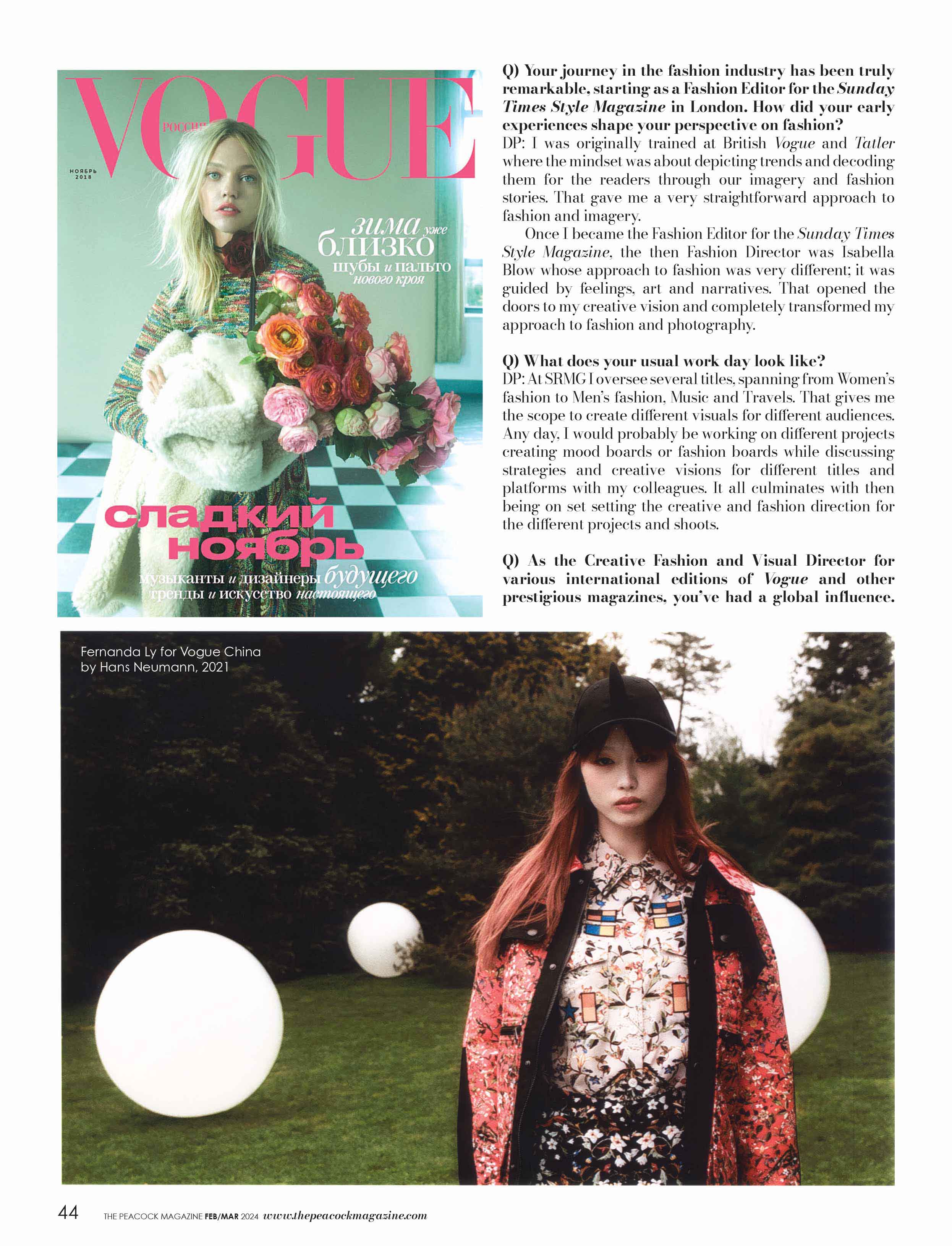
Q) Your journey in the fashion industry has been truly remarkable, starting as a Fashion Editor for the Sunday Times Style Magazine in London. How did your early experiences shape your perspective on fashion?
I was originally trained at British Vogue and Tatler where the mindset was about depicting trends and decoding them for the readers through our imagery and fashion stories. That gave me a very straightforward approach to fashion and imagery.
Once I became the Fashion Editor for the Sunday Times Style Magazine, the then Fashion Director was Isabella Blow whose approach to fashion was very different; it was guided by feelings, art and narratives. That opened the doors to my creative vision and completely transformed my approach to fashion and photography.
Q) What does your usual work day look like?
At SRMG I oversee several titles, spanning from Women’s fashion to Men’s fashion, Music and Travels. That gives me the scope to create different visuals for different audiences. Any day, I would probably be working on different projects creating mood boards or fashion boards while discussing strategies and creative visions for different titles and platforms with my colleagues. It all culminates with then being on set setting the creative and fashion direction for the different projects and shoots.
Q) As the Creative Fashion and Visual Director for various international editions of Vogue and other prestigious magazines, you’ve had a global influence. How do you approach the creative direction for different markets, considering cultural nuances and preferences?
I seem to have the ability to feel the culture and the world around me. When approaching new countries or cultures I rely on my observations and intuition to understand the cultural nuances. It allows me to approach and tailor my vision to new audiences and platforms. This natural ability has served me extremely well allowing me to apply the concept of “local within the global”. That’s always been my method of fulfilling the different roles I have held over the years, all over the world.

Q) Working with renowned photographers such as Nick Knight, Paolo Roversi, and Ryan McGinley, you’ve collaborated with both established and emerging talents. How do you select and foster relationships with photographers, and what qualities do you look for in a collaboration?
I select the talents and artists to collaborate with based on the specific project I work on. I create the mood board and the vision, the concept or the narrative I want to portray and based on that I would research the artist who can bring my vision to life.
Q) Can you share a memorable experience or project that stands out among the diverse range of photographers you’ve worked with?
Every project is special to me, but I do feel lucky to have had the opportunity to work with Helmut Newton before he passed. Also, my work with Nick Knight has felt very special as far as bringing my vision to life.
Q) Your role at SRMG involves overseeing Fashion & Lifestyle Titles. Can you share the key challenges and opportunities you’ve encountered in curating content for a diverse audience within the Saudi Media and Research Company?
My experience with Middle Eastern culture and audiences is very recent so right now I am at the most enjoyable phase of discovery. It is a great creative journey to understand what fashion and photography mean to them.
Q) Having contributed to a variety of international titles, from Vogue Japan to US Vanity Fair, how do you adapt your creative direction to cater to the distinct styles and expectations of each publication?
I consider the branding strategy of each title identifying what they stand for and the audience they want to speak to. Based on that I would adapt my vision to those parameters
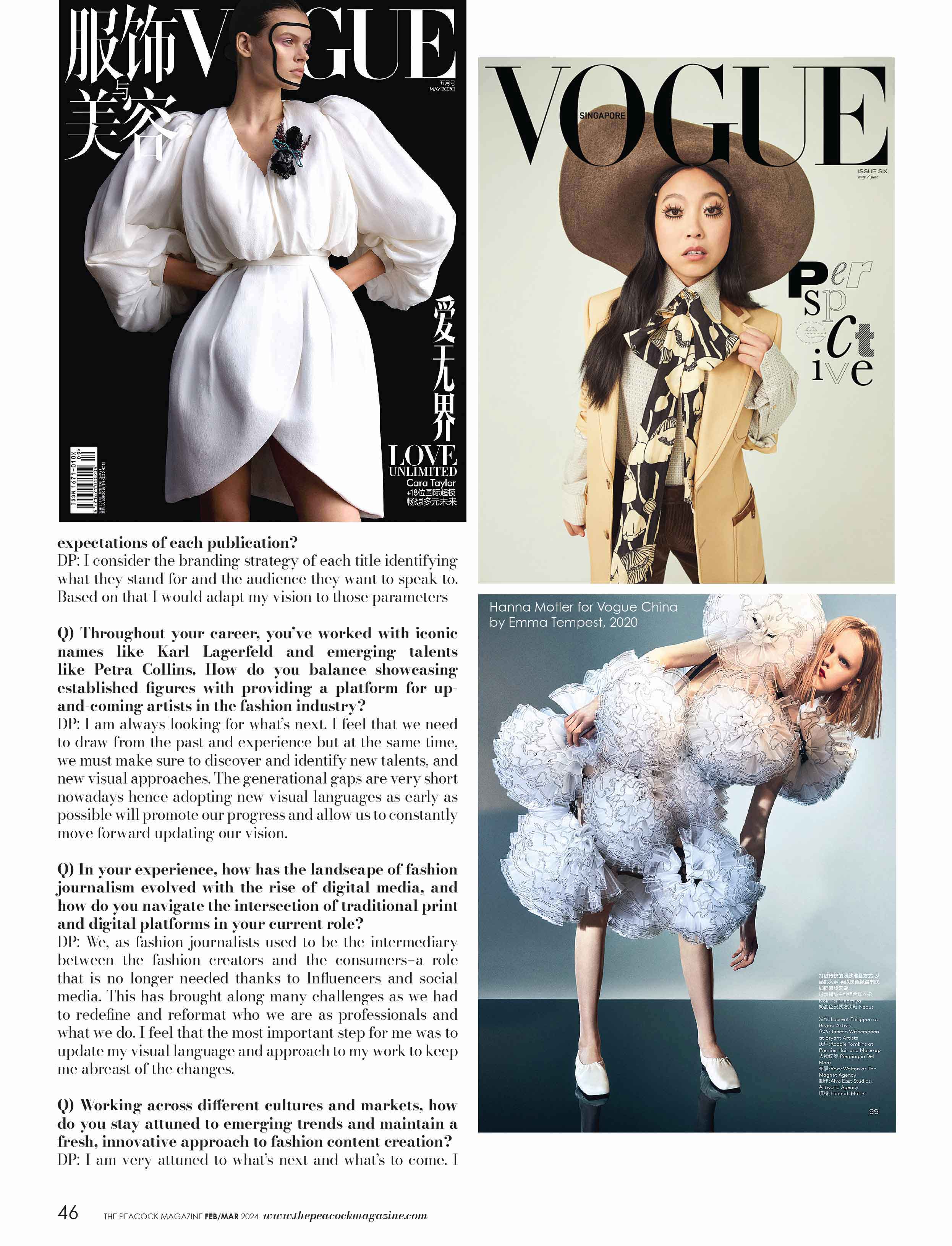
Q) Throughout your career, you’ve worked with iconic names like Karl Lagerfeld and emerging talents like Petra Collins. How do you balance showcasing established figures with providing a platform for up-and-coming artists in the fashion industry?
I am always looking for what’s next. I feel that we need to draw from the past and experience but at the same time, we must make sure to discover and identify new talents, and new visual approaches. The generational gaps are very short nowadays hence adopting new visual languages as early as possible will promote our progress and allow us to constantly move forward updating our vision.
Q) In your experience, how has the landscape of fashion journalism evolved with the rise of digital media, and how do you navigate the intersection of traditional print and digital platforms in your current role?
We, as fashion journalists used to be the intermediary between the fashion creators and the consumers–a role that is no longer needed thanks to Influencers and social media. This has brought along many challenges as we had to redefine and reformat who we are as professionals and what we do. I feel that the most important step for me was to update my visual language and approach to my work to keep me abreast of the changes.
Q) Working across different cultures and markets, how do you stay attuned to emerging trends and maintain a fresh, innovative approach to fashion content creation?
I am very attuned to what’s next and what’s to come. I am very intuitive, and I seem to possess what I have come to define as “antennae”. I have always found myself to be a little ahead of the curve and interested in things right before they become mainstream.
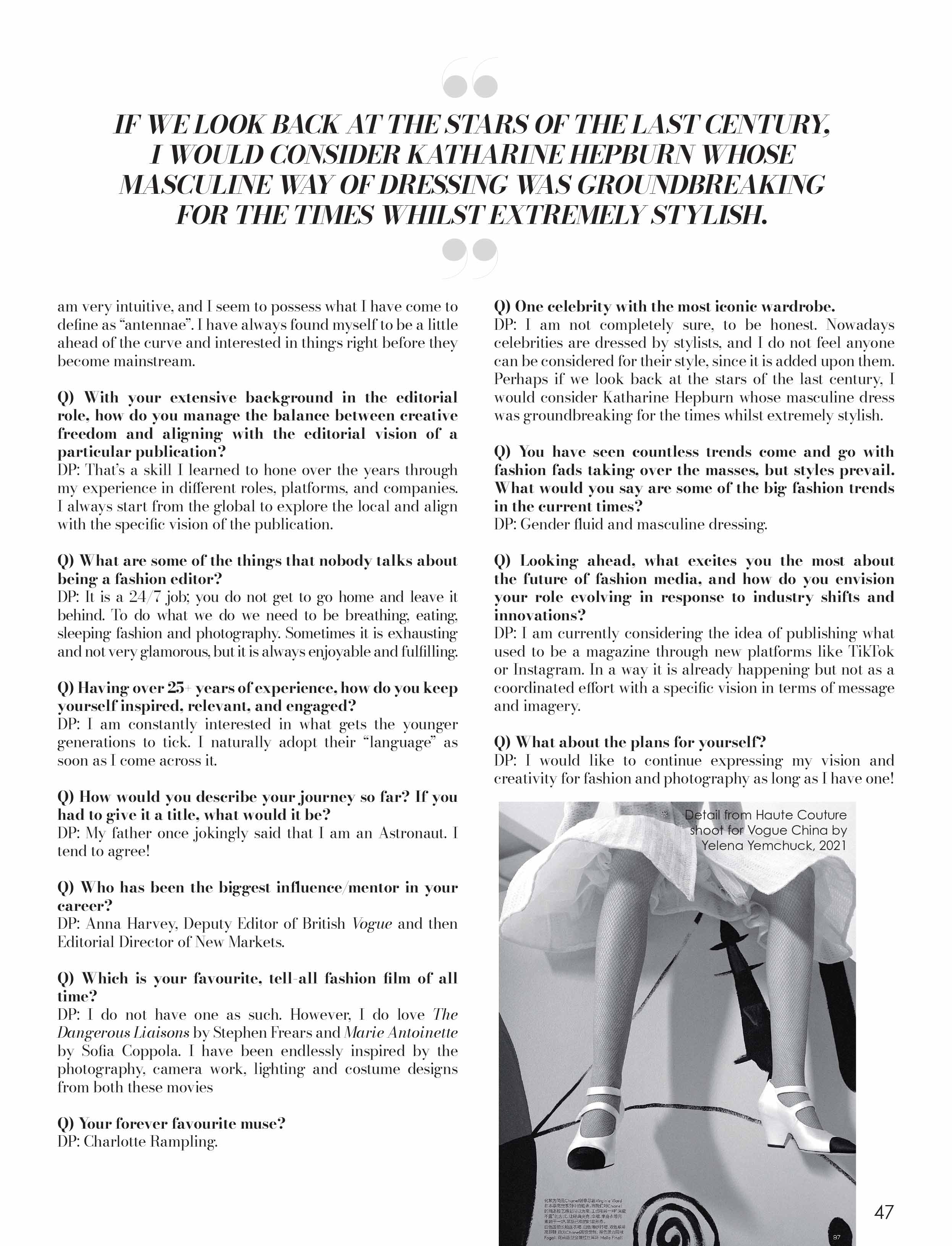
Q) With your extensive background in the editorial role, how do you manage the balance between creative freedom and aligning with the editorial vision of a particular publication?
That’s a skill I learned to hone over the years through my experience in different roles, platforms, and companies. I always start from the global to explore the local and align with the specific vision of the publication.
Q) What are some of the things that nobody talks about being a fashion editor?
It is a 24/7 job; you do not get to go home and leave it behind. To do what we do we need to be breathing, eating, sleeping fashion and photography. Sometimes it is exhausting and not very glamorous, but it is always enjoyable and fulfilling.
Q) Having over 25+ years of experience, how do you keep yourself inspired, relevant, and engaged?
I am constantly interested in what gets the younger generations tick. I naturally adopt their “language” as soon as I come across it.
Q) How would you describe your journey so far? If you had to give it a title, what would it be?
My father once jokingly said that I am an Astronaut. I tend to agree!
Q) Who has been the biggest influence/mentor in your career?
Anna Harvey, Deputy Editor of British Vogue and then Editorial Director of New Markets.
Q) Which is your favourite, tell-all fashion film of all time?
I do not have one as such. However, I do love The Dangerous Liaisons by Stephen Frears and Marie Antoinette by Sofia Coppola. I have been endlessly inspired by the photography, camera work, lighting and costume designs from both these movies
Q) Your forever favourite muse?
Charlotte Rampling.
Q) One celebrity with the most iconic wardrobe.
I am not completely sure, to be honest. Nowadays celebrities are dressed by stylists, and I do not feel anyone can be considered for their style, since it is added upon them. Perhaps if we look back at the stars of the last century, I would consider Katharine Hepburn whose masculine way of dressing was groundbreaking for the times whilst extremely stylish.
Q) You have seen countless trends come and go with fashion fads taking over the masses, but styles prevail. What would you say are some of the big fashion trends in the current times?
Gender fluid and masculine dressing.
Q) Looking ahead, what excites you the most about the future of fashion media, and how do you envision your role evolving in response to industry shifts and innovations?
I am currently considering the idea of publishing what used to be a magazine through new platforms like TikTok or Instagram. In a way it is already happening but not as a coordinated effort with a specific vision in terms of message and imagery.
Q) What about the plans for yourself?
I would like to continue expressing my vision and creativity for fashion and photography as long as I have one!
